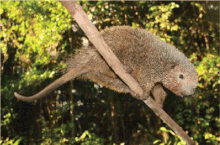Bristle-spined rat
| Bristle-spined rat | |
|---|---|

| |
| Scientific classification | |
| Domain: | Eukaryota |
| Kingdom: | Animalia |
| Phylum: | Chordata |
| Class: | Mammalia |
| Order: | Rodentia |
| Family: | Erethizontidae |
| Subfamily: | Chaetomyinae Thomas, 1897 |
| Genus: | Chaetomys J. E> Gray, 1843 |
| Species: | C. subspinosus |
| Binomial name | |
| Chaetomys subspinosus (Olfers, 1818) | |

| |
The bristle-spined rat (Chaetomys subspinosus) is an arboreal rodent from the Atlantic forest in eastern Brazil. Also known as the bristle-spined porcupine or thin-spined porcupine, it is the only member of the genus Chaetomys and the subfamily Chaetomyinae.[2] It was officially described in 1818, but rarely sighted since, until December 1986, when two specimens - one a pregnant female - were found in the vicinity of Valencia in Bahia.[3] Since then it has been recorded at several localities in eastern Brazil, from Sergipe to Espírito Santo (there are no recent records from Rio de Janeiro), but it remains rare and threatened due to habitat loss, poaching and roadkills.[4]
Characteristics
Bristle-spined rats are named because the spines on the back are more bristle-like in texture than the spines on the rest of the body. They have long, naked tails which are not prehensile. Adult animals weigh around 1.3 kg (2.9 lb).
Their skulls are unusual in several ways. The eye socket is almost completely surrounded by a ring of bone. Incisors are distinctly narrow. Overall, the animal displays a mix of New World porcupine cranial characters, spiny rat cranial characters, and characters that set it apart from all other rodents.
The bristle-spined rat is restricted to remnant forests and forest edges in the Atlantic coastal forests on the east coast of Brazil. Its habitat is dwindling rapidly and the species may be vulnerable to extinction. It is classified as vulnerable by IUCN and endangered by USDI.[5]
Taxonomic controversy
No consensus has been reached as to the taxonomic position of Chaetomys. It is commonly placed with the New World porcupines in the family Erethizontidae or with the spiny rats the family Echimyidae. Both are South American hystricognaths with hairs modified as spines or quills. Chaetomys has more highly developed spines than the spiny rats, but less developed than the porcupines. Characteristics of the premolar suggest that it belongs with the Echimyidae, but characteristics of the incisor enamel suggest that it belongs in the Erethizontidae.
Patterson and Pascual (1968), Patterson and Wood (1982), Woods (1982, 1984, 1993) Patton and Reig (1989), Nowak (1999), and Carvalho (2000) support the inclusion of this animal in Echimyidae whereas Martin (1994), McKenna and Bell (1997), Carvalho and Salles (2004), and Woods and Kilpatrick (2005) argue that it belongs in Erethizontidae. Emmons (2005) mentions the family Chaetomyidae without much further comment except to exclude it from Echimyidae.
A molecular phylogeny based on the mitochondrial gene coding for cytochrome b combined to karyological evidence actually suggests that Chaetomys is more closely related to the Erethizontidae than to the Echimyidae, although it branches as the sister group to the rest of the Erethizontidae.[6]
References
- ^ Catzeflis, F.; Patton, J.; Percequillo, A.; Bonvicino, C.R.; Weksler, M. (2017). "Chaetomys subspinosus". IUCN Red List of Threatened Species. 2017: e.T4366A22213335. doi:10.2305/IUCN.UK.2017-2.RLTS.T4366A22213335.en. Retrieved 19 November 2021.
- ^ Woods, C.A.; Kilpatrick, C.W. (2005). "Infraorder Hystricognathi". In Wilson, D.E.; Reeder, D.M (eds.). Mammal Species of the World: A Taxonomic and Geographic Reference (3rd ed.). Johns Hopkins University Press. p. 1546. ISBN 978-0-8018-8221-0. OCLC 62265494.
- ^ Karl Shuker; Gerald Durrell (1993). Lost Ark: New and Rediscovered Animals of the Twentieth Century. HarperCollins Publishers. pp. 89–90. ISBN 0-00-219943-2.
- ^ Srbek-Araujo, A.C.; A.d.C. Alvarenga; A.T. Bertoldi (2018). "Do we underestimate the impact of roads on arboreal animals? Roadkill as an important threat to Chaetomys subspinosus (Mammalia: Rodentia)". Biota Neotropica. 18 (3): e20170511.
- ^ Nowak, 1999
- ^ Vilela, R.V.; Machado, T.; Ventura, K.; Fagundes, V.; Silva, M.J.; Yonenaga-Yassuda, Y. (2009). "The taxonomic status of the endangered thin-spined porcupine, Chaetomys subspinosus (Olfers, 1818), based on molecular and karyologic data". BMC Evolutionary Biology. 9: 29. doi:10.1186/1471-2148-9-29. PMC 2646700. PMID 19192302.
Further reading
- Carvalho, 2000. Substitution of the deciduous premolar in Chaetomys subspinosus (Olfers, 1818) (Hystricognathi, Rodentia) and its taxonomic implications. Zeitschrift für Säugetierkunde, 65:187-190.
- Carvalho, G. A. S. and L. O. Salles. 2004. Relationships among extant and fossil echimyids. Zoological Journal of the Linnean Society, 142:445-477.
- Emmons, L.H. 2005. A Revision of the Genera of Arboreal Echimyidae (Rodentia: Echimyidae, Echimyinae), With Descriptions of Two New Genera. pp. 247–310 in Lacey, E.A. & Myers, P. 2005. Mammalian Diversification: From Chromosomes to Phylogeography (A Celebration of the Career of James L. Patton). University of California Publications in Zoology.
- Martin, T. 1994. On the systematic position of Chaetomys subspinosus (Rodentia: Caviomorpha) based on evidence from the incisor enamel microstructure. Journal of Mammalian Evolution, 2:117-131.
- McKenna, Malcolm C., and Bell, Susan K. 1997. Classification of Mammals Above the Species Level. Columbia University Press, New York, 631 pp. ISBN 0-231-11013-8
- Nowak, R. M. 1999. Walker's Mammals of the World, Vol. 2. Johns Hopkins University Press, London.
- Patton, J. L. and O. A. Reig. 1989. Genetic differentiation among echimyid rodents, with emphasis on spiny rats, genus Proechimys. pp. 75–96 in Neotropical Mammalogy (K. H. Redford and J. F. Eisenberg, eds.). Sandhill Crane Press, Gainesville.
- Patterson, B. and R. Pascual. 1968. New echimyid rodents from the Oligoceneof Patagonia, and a synopsis of the family. Brevioria, 301:1-14.
- Patterson, B. and A. E. Wood. 1982. Rodents from the Deseadan Oligocene of Bolivia and the relationships of the Caviomorpha. Bulletin of the Museum of Comparative Zoology, 149:371-543.
- Woods, C. A. 1982. The history and classification of the South American hystricognath rodents: Reflections on the far away and long ago. Pymatuning Laboratory of Ecology Special Publication, 6:377-392.

